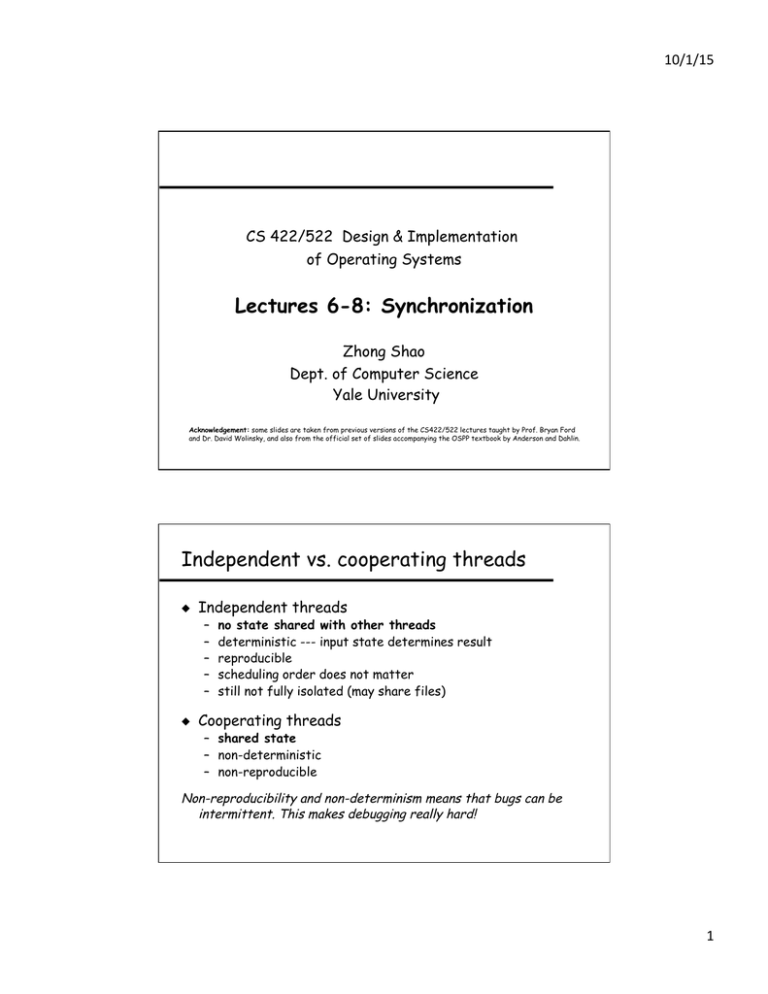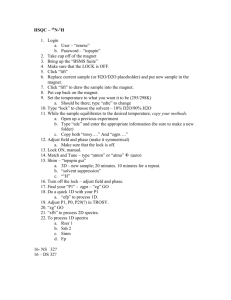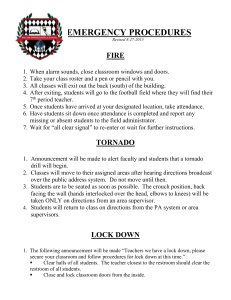Document 10733338
advertisement

10/1/15 CS 422/522 Design & Implementation
of Operating Systems
Lectures 6-8: Synchronization
Zhong Shao
Dept. of Computer Science
Yale University
Acknowledgement: some slides are taken from previous versions of the CS422/522 lectures taught by Prof. Bryan Ford
and Dr. David Wolinsky, and also from the official set of slides accompanying the OSPP textbook by Anderson and Dahlin.
Independent vs. cooperating threads
◆
Independent threads
–
–
–
–
–
◆
no state shared with other threads
deterministic --- input state determines result
reproducible
scheduling order does not matter
still not fully isolated (may share files)
Cooperating threads
– shared state
– non-deterministic
– non-reproducible
Non-reproducibility and non-determinism means that bugs can be
intermittent. This makes debugging really hard!
1 10/1/15 Example: two threads, one counter
◆
◆
Yahoo gets millions of hits a day. Uses multiple
threads (on multiple processors) to speed things up.
Simple shared state error: each thread increments a
shared counter to track the number of hits today:
…
hits = hits + 1;
…
◆
What happens when two threads execute this code
concurrently?
Problem with shared counters
◆
One possible result: lost update!
hits = 0
time
T1
read hits (0)
hits = 0 + 1
hits = 1
◆
T2
read hits (0)
hits = 0 + 1
One other possible result: everything works.
– Bugs are frequently intermittent. Makes debugging hard.
– This is called “race condition”
2 10/1/15 Race conditions
◆
Race condition: timing dependent error involving
shared state.
– whether it happens depends on how threads scheduled
◆
*Hard* because:
– must make sure all possible schedules are safe. Number of
possible schedules permutations is huge.
if(n == stack_size) /* A */
return full; /* B */
stack[n] = v;
/* C */
n = n + 1;
/* D */
* Some bad schedules aaccdd, acadcd, … (how many?)
– they are intermittent. Timing dependent = small changes (adding a
print stmt, different machine) can hide bug.
More race condition example:
Thread a:
i = 0;
while(i < 10)
i = i + 1;
print “A won!”;
Thread b:
i = 0;
while(i > -10)
i = i - 1;
print “B won!”;
• Who wins?
• Guaranteed that someone wins?
• What if both threads on its own identical speed CPU
executing in parallel? will it go on forever?
3 10/1/15 Preventing race conditions: atomicity
◆
atomic unit = instruction sequence guaranteed to
execute indivisibly (also, a “critical section”).
* If two threads execute the same atomic unit at the same time, one
thread will execute the whole sequence before the other begins.
hits = 0
time
T2
T1
hits = hits + 1
hits = hits + 1
hits = 2
◆
How to make multiple inst’s seem like one atomic one?
Synchronization motivation
◆
When threads concurrently read/write shared memory,
program behavior is undefined à race conditions
– Two threads write to the same variable; which one should win?
◆
Thread schedule is non-deterministic
– Behavior changes when re-run program
◆
Compiler/hardware instruction reordering
◆
Multi-word operations are not atomic
4 10/1/15 Question: can this panic?
Thread 1
Thread 2
p = someComputation();
pInitialized = true;
while (!pInitialized)
;
q = someFunction(p);
if (q != someFunction(p))
panic
Why reordering?
◆
Why do compilers reorder instructions?
– Efficient code generation requires analyzing control/data
dependency
– If variables can spontaneously change, most compiler
optimizations become impossible
◆
Why do CPUs reorder instructions?
– Write buffering: allow next instruction to execute while
write is being completed
Fix: memory barrier
– Instruction to compiler/CPU
– All ops before barrier complete before barrier returns
– No op after barrier starts until barrier returns
5 10/1/15 Example: the Too-Much-Milk problem
3:00
3:05
3:10
3:15
3:20
3:25
3:30
Person A
Look in fridge. Out of milk
Leave for store
Arrive at store
Buy milk
Arrive home, put milk away
Person B
Look in fridge. Out of milk
Leave for store
Arrive at store
Buy milk
Arrive home, put milk away
Oh no !
Goal: 1. never more than one person buys
2. someone buys if needed
Too much milk: solution #1
◆
Basic idea:
– leave a note (kind of like “lock”)
– remove note (kind of like “unlock”)
– don’t buy if there is a note (wait)
if (noMilk) {
if (noNote) {
leave Note;
buy milk;
remove Note
}
}
6 10/1/15 Why solution #1 does not work ?
3:00
3:05
3:10
3:15
3:20
3:25
3:30
Thread A
if (noMilk) {
if (noNote) {
leave Note;
buy milk;
remove Note} }
Thread B
if (noMilk) {
if (noNote) {
leave Note;
buy milk;
remove Note } }
Threads can get context-switched at any time !
Too much milk: solution #2
Thread A
leave NoteA
if (noNoteB) {
if (noMilk)
buy milk
}
remove NoteA
Thread B
leave NoteB
if (noNoteA) {
if (noMilk)
buy milk
}
remove NoteB
Problem:
neither thread to buy milk --- think
other is going to buy --- starvation !
7 10/1/15 Too much milk: solution #3
Thread A
leave NoteA
while (NoteB)
do nothing;
if (noMilk)
buy milk;
remove NoteA
Thread B
// X
leave NoteB
if (noNoteA) {
if (noMilk)
buy milk;
}
remove NoteB
// Y
Either safe for me to buy or others will buy !
It works but:
• it is too complex
• A’s code different from B’s (what if lots of threads ?)
• A busy-waits --- consumes CPU !
A better solution
◆
◆
◆
Have hardware provide better primitives than atomic
load and store.
Build higher-level programming abstractions on this
new hardware support.
Example: using locks as an atomic building block
Acquire --- wait until lock is free, then grabs it
Release --- unlock, waking up a waiter if any
These must be atomic operations --- if two threads are waiting
for the lock, and both see it is free, only one grabs it!
8 10/1/15 Too much milk: using a lock
◆
It is really easy !
lock -> Acquire();
if (nomilk)
buy milk;
lock -> Release();
◆
What makes a good solution?
◆
Future topics:
–
–
–
–
–
Only one process inside a critical section
No assumption about CPU speeds
Processes outside of critical section should not block other processes
No one waits forever
Works for multiprocessors
– hardware support for synchronization
– high-level synchronization primitives & programming abstraction
– how to use them to write correct concurrent programs?
A few definitions
◆
Sychronization:
– using atomic operations to ensure cooperation between threads
◆
Mutual exclusion:
– ensuring that only one thread does a particular thing at a time. One
thread doing it excludes the other, and vice versa.
◆
Critical section:
– piece of code that only one thread can execute at once. Only one
thread at a time will get into the section of code.
◆
Lock: prevents someone from doing something
– lock before entering critical section, before accessing shared data
– unlock when leaving, after done accessing shared data
– wait if locked
9 10/1/15 A quick recap
◆
We talked about critical section
Acquire(lock);
if (noMilk)
buy milk;
Release(lock);
◆
Critical section
We also talked about what is a good solution
– Only one process inside a critical section
– No assumption about CPU speeds
– Processes outside of critical section should not block other
processes
– No one waits forever
– Works for multiprocessors
How to write concurrent programs?
Use shared objects (aka concurrent objects) --- always
encapsulate (hide) its shared state
Shared Objects
Public Methods
Threads
State
Variables
Synchronization
Variables
10 10/1/15 The big picture
Concurrent Applications
Shared Objects
Bounded Buffer
Barrier
Synchronization Variables
Semaphores
Locks
Condition Variables
Atomic Instructions
Interrupt Disable
Test-and-Set
Hardware
Multiple Processors
Hardware Interrupts
The big picture (cont’d)
◆
◆
◆
Shared object layer: all shared objects appear to have
the same interface as those for a single-threaded
program
Synchronization variable layer: a synchronization
variable is a data structure used for coordinating
concurrent access to shared state
Atomic instruction layer: atomic processor-specific
instructions
11 10/1/15 The big picture
Concurrent Applications
Shared Objects
Bounded Buffer
Barrier
Synchronization Variables
Semaphores
Locks
Condition Variables
Atomic Instructions
Interrupt Disable
Test-and-Set
Hardware
Multiple Processors
Hardware Interrupts
Locks
◆
Lock::acquire
– wait until lock is free, then take it
◆
Lock::release
– release lock, waking up anyone waiting for it
1.
At most one lock holder at a time (safety)
2.
If no one holding, acquire gets lock (progress)
3.
If all lock holders finish and no higher priority
waiters, waiter eventually gets lock (progress)
12 10/1/15 Question: why only Acquire/Release
◆
Suppose we add a method to a lock, to ask if the lock
is free. Suppose it returns true. Is the lock:
– Free?
– Busy?
– Don’t know?
Lock example: malloc/free
char *malloc (n) {
void free(char *p) {
heaplock.acquire();
heaplock.acquire();
p = allocate memory
put p back on free list
heaplock.release();
heaplock.release();
}
return p;
}
13 10/1/15 Rules for using locks
◆
◆
Lock is initially free
Always acquire before accessing shared data structure
– Beginning of procedure!
◆
Always release after finishing with shared data
– End of procedure!
– Only the lock holder can release
– DO NOT throw lock for someone else to release
◆
Never access shared data without lock
– Danger!
Will this code work?
if (p == NULL) {
lock.acquire();
if (p == NULL) {
p = newP();
}
lock.release();
}
use p->field1
newP() {
p = malloc(sizeof(p));
p->field1 = …
p->field2 = …
return p;
}
14 10/1/15 Example: thread-safe bounded queue
queue1
// Thread-safe queue interface
lock
const int MAX = 10;
items[0]
class TSQueue {
// Synchronization variables
Lock lock;
items[1]
// State variables
int items[MAX];
int front;
int nextEmpty;
public:
TSQueue();
~TSQueue(){};
bool tryInsert(int item);
bool tryRemove(int *item);
};
…
front
nextEmpty
queue2
queue3
lock
lock
items[0]
items[0]
items[1]
items[1]
…
…
front
nextEmpty
front
nextEmpty
Example: thread-safe bounded queue
// Initialize the queue to empty
// and the lock to free.
TSQueue::TSQueue() {
front = nextEmpty = 0;
}
// Try to insert an item.
// If the queue is full, return false;
// otherwise return true.
// Try to remove an item. If the queue
// is empty, return false;
// otherwise return true.
bool TSQueue::tryInsert(int item) {
bool success = false;
bool TSQueue::tryRemove(int *item) {
bool success = false;
}
lock.acquire();
if ((nextEmpty - front) < MAX) {
items[nextEmpty % MAX] = item;
nextEmpty++;
success = true;
}
lock.release();
return success;
}
lock.acquire();
if (front < nextEmpty) {
*item = items[front % MAX];
front++;
success = true;
}
lock.release();
return success;
15 10/1/15 Example: thread-safe bounded queue
The lock holder always maintain the following invariants
when releasing the lock:
– The total number of items ever inserted in the queue is
nextEmpty.
– The total number of items ever removed from the queue is
front.
– front <= nextEmpty
– The current number of items in the queue is nextEmpty –
front
– nextEmpty – front <= MAX
Example: thread-safe bounded queue
// TSQueueMain.cc
// Test code for TSQueue.
int main(int argc, char **argv) {
TSQueue *queues[3];
sthread_t workers[3];
int i, j;
// Start worker threads to insert.
for (i = 0; i < 3; i++) {
queues[i] = new TSQueue();
thread_create(&workers[i],
putSome, queues[i]);
}
// Wait for some items to be put.
thread_join(workers[0]);
}
// Remove 20 items from each queue.
for (i = 0; i < 3; i++) {
printf("Queue %d:\n", i);
testRemoval(&queues[i]);
}
// Insert 50 items into a queue.
void *putSome(void *p) {
TSQueue *queue = (TSQueue *)p;
int i;
}
for (i = 0; i < 50; i++) {
queue->tryInsert(i);
}
return NULL;
// Remove 20 items from a queue.
void testRemoval(TSQueue *queue) {
int i, item;
}
for (i = 0; i < 20; j++) {
if (queue->tryRemove(&item))
printf("Removed %d\n", item);
else
printf("Nothing there.\n");
}
}
16 10/1/15 The big picture
Concurrent Applications
Shared Objects
Bounded Buffer
Barrier
Synchronization Variables
Semaphores
Locks
Condition Variables
Atomic Instructions
Interrupt Disable
Test-and-Set
Hardware
Multiple Processors
Hardware Interrupts
How to use the lock ?
◆
◆
The lock provides mutual exclusion to the shared data
Rules for using a lock:
– Always acquire before accessing shared data structure
– Always release after finishing with shared data
– Lock is initially free.
◆
Simple example: a synchronized queue
bool tryInsert()
{
lock.Acquire();
// lock before use
… put item on queue; // ok to access
lock.Release();
// unlock after done
return success;
}
bool tryRemove()
{ …
lock.Acquire();
if something on queue
remove it;
lock->Release();
return success;
}
// can we wait?
17 10/1/15 Condition variables
◆
How to make tryRemove wait until something is on the
queue?
– can’t sleep while holding the lock
– Key idea: make it possible to go to sleep inside critical section,
by atomically releasing lock at same time we go to sleep.
◆
Condition variable: a queue of threads waiting for
something inside a critical section.
– Wait() --- Release lock, go to sleep, re-acquire lock
* release lock and going to sleep is atomic
– Signal() --- Wake up a waiter, if any
– Broadcast() --- Wake up all waiters
Synchronized queue using condition variables
◆
Rule: must hold lock when doing condition variable
operations
AddToQueue()
{
lock.acquire();
RemoveFromQueue()
{
lock.acquire();
while nothing on queue
condition.wait(&lock);
put item on queue;
condition.signal();
}
// release lock; got to
// sleep; reacquire lock
lock.release();
}
remove item from queue;
lock.release();
return item;
18 10/1/15 Condition variable design pattern
methodThatWaits() {
lock.acquire();
methodThatSignals() {
lock.acquire();
// Read/write shared state
// Read/write shared state
while (!testSharedState()) {
cv.wait(&lock);
}
// If testSharedState is now true
cv.signal(&lock);
// Read/write shared state
// Read/write shared state
}
lock.release();
}
lock.release();
Example: blocking bounded queue
// Thread-safe blocking queue.
const int MAX = 10;
class BBQ{
// Synchronization variables
Lock lock;
CV itemAdded;
CV itemRemoved;
// State variables
int items[MAX];
int front;
int nextEmpty;
public:
BBQ();
~BBQ() {};
void insert(int item);
int remove();
};
19 10/1/15 Example: blocking bounded queue
//Wait until there is room and
// then insert an item.
void BBQ::insert(int item) {
// Wait until there is an item and
// then remove an item.
int BBQ::remove() {
int item;
lock.acquire();
while ((nextEmpty - front) == MAX) {
itemRemoved.wait(&lock);
}
items[nextEmpty % MAX] = item;
nextEmpty++;
itemAdded.signal();
}
lock.release();
}
lock.acquire();
while (front == nextEmpty) {
itemAdded.wait(&lock);
}
item = items[front % MAX];
front++;
itemRemoved.signal();
lock.release();
return item;
// Initialize the queue to empty,
// the lock to free, and the
// condition variables to empty.
BBQ::BBQ() {
front = nextEmpty = 0;
}
Pre/Post conditions
◆
What is state of the blocking bounded queue at lock
acquire?
– front <= nextEmpty
– front + MAX >= nextEmpty
◆
These are also true on return from wait
◆
And at lock release
◆
Allows for proof of correctness
20 10/1/15 Pre/Post conditions
methodThatWaits() {
lock.acquire();
// Pre-condition: State is consistent
}
methodThatSignals() {
lock.acquire();
// Pre-condition: State is consistent
// Read/write shared state
// Read/write shared state
while (!testSharedState()) {
cv.wait(&lock);
}
// WARNING: shared state may
// have changed! But
// testSharedState is TRUE
// and pre-condition is true
// If testSharedState is now true
cv.signal(&lock);
// Read/write shared state
lock.release();
// NO WARNING: signal keeps lock
}
// Read/write shared state
lock.release();
Condition variables
◆
ALWAYS hold lock when calling wait, signal, broadcast
– Condition variable is sync FOR shared state
– ALWAYS hold lock when accessing shared state
◆
Condition variable is memoryless
– If signal when no one is waiting, no op
– If wait before signal, waiter wakes up
◆
Wait atomically releases lock
– What if wait, then release?
– What if release, then wait?
21 10/1/15 Question 1: wait replaced by unlock + sleep?
methodThatWaits() {
lock.acquire();
// Read/write shared state
// Read/write shared state
while (!testSharedState()) {
lock.release()
cv.sleep(&lock);
}
// If testSharedState is now true
// Read/write shared state
}
methodThatSignals() {
lock.acquire();
lock.release();
cv.signal(&lock);
// Read/write shared state
}
lock.release();
Question 2: wait does not acquire lock?
methodThatWaits() {
lock.acquire();
// Read/write shared state
// Read/write shared state
while (!testSharedState()) {
cv.wait (&lock);
lock.acquire();
}
// If testSharedState is now true
// Read/write shared state
}
methodThatSignals() {
lock.acquire();
lock.release();
cv.signal(&lock);
// Read/write shared state
}
lock.release();
22 10/1/15 Condition variables, cont’d
◆
When a thread is woken up from wait, it may not run
immediately
– Signal/broadcast put thread on ready list
– When lock is released, anyone might acquire it
◆
Wait MUST be in a loop
while (needToWait()) {
condition.Wait(lock);
}
◆
Simplifies implementation
– Of condition variables and locks
– Of code that uses condition variables and locks
Structured synchronization
◆
◆
Identify objects or data structures that can be
accessed by multiple threads concurrently
Add locks to object/module
– Grab lock on start to every method/procedure
– Release lock on finish
◆
If need to wait
– while(needToWait()) { condition.Wait(lock); }
– Do not assume when you wake up, signaller just ran
◆
If do something that might wake someone up
– Signal or Broadcast
◆
Always leave shared state variables in a consistent state
– When lock is released, or when waiting
23 10/1/15 Monitors and condition variables
◆
Monitor definition:
– a lock and zero or more condition variables for managing
concurrent access to shared data
◆
Monitors make things easier:
– “locks” for mutual exclusion
– “condition variables” for scheduling constraints
Monitors embedded in prog. languages (1)
◆
High-level data abstraction that unifies handling of:
– Shared data, operations on it, synch and scheduling
* All operations on data structure have single (implicit) lock
* An operation can relinquish control and wait on condition
// only one process at time can update instance of Q
class Q {
int head, tail; // shared data
void enq(v) { locked access to Q instance }
int deq() { locked access to Q instance }
}
– Java from Sun; Mesa/Cedar from Xerox PARC
◆
Monitors easier and safer than semaphores
– Compiler can check, lock implicit (cannot be forgotten)
24 10/1/15 Monitors embedded in prog. languages (2)
◆
Wait()
– Block on “condition”
◆
Signal()
– Wakeup a blocked
process on “condition”
Queues
associated
with x, y
condition
s
x
y
Shared
data
...
Entry queue
operations
Java language manual
When waiting upon a Condition, a “spurious wakeup” is
permitted to occur, in general, as a concession to the
underlying platform semantics. This has little practical
impact on most application programs as a Condition
should always be waited upon in a loop, testing the
state predicate that is being waited for.
25 10/1/15 Remember the rules
◆
◆
◆
◆
◆
◆
Use consistent structure
Always use locks and condition variables
Always acquire lock at beginning of procedure, release
at end
Always hold lock when using a condition variable
Always wait in while loop
Never spin in sleep()
Mesa vs. Hoare semantics
◆
Mesa
– Signal puts waiter on ready list
– Signaller keeps lock and processor
◆
Hoare
– Signal gives processor and lock to waiter
– When waiter finishes, processor/lock given back to signaller
– Nested signals possible!
◆
For Mesa-semantics, you always need to check the
condition after wait (use “while”). For Hoare-semantics
you can change it to “if”
26 10/1/15 The big picture: more examples
Concurrent Applications
Shared Objects
Bounded Buffer
Barrier
Synchronization Variables
Semaphores
Locks
Condition Variables
Atomic Instructions
Interrupt Disable
Test-and-Set
Hardware
Hardware Interrupts
Multiple Processors
Producer-consumer with monitors
Condition full;
Condition empty;
Lock lock;
Producer() {
lock.Acquire();
}
Consumer() {
lock.Acquire();
while (the buffer is full)
full.wait(&lock);
while (the buffer is empty)
empty.wait(&lock);
put 1 Coke in machine;
take 1 Coke;
if (the buffer was empty)
empty.signal();
lock.Release();
if (the buffer was full)
full.signal();
lock.Release();
}
27 10/1/15 Example: the readers/writers problem
◆
Motivation
– shared database (e.g., bank balances / airline seats)
– Two classes of users:
* Readers --- never modify database
* Writers --- read and modify database
– Using a single lock on the database would be overly restrictive
* want many readers at the same time
* only one writer at the same time
◆
Constraints
* Readers can access database when no writers (Condition okToRead)
* Writers can access database when no readers or writers (Condition
okToWrite)
* Only one thread manipulates state variable at a time
Design specification (readers/writers)
◆
Reader
– wait until no writers
– access database
– check out - wake up waiting writer
◆
Writer
– wait until no readers or writers
– access data base
– check out --- wake up waiting readers or writer
◆
State variables
– # of active readers (AR); # of active writers (AW);
– # of waiting readers (WR); # of waiting writers (WW);
◆
Lock and condition variables: okToRead, okToWrite
28 10/1/15 Solving readers/writers
Reader() {
Writer() {
// first check self into system
// first check self into system
lock.Acquire();
while ((AW+WW) > 0) {
WR ++;
okToRead.Wait(&lock);
WR --;
}
AR++;
lock.Release();
lock.Acquire();
while ((AW+AR) > 0) {
WW ++;
okToWrite.Wait(&lock);
WW --;
}
AW++;
lock.Release();
Access DB;
Access DB;
// check self out of system
// check self out of system
lock.Acquire();
AR--;
if (AR == 0 && WW > 0)
okToWrite.Signal(&lock);
lock.Release();
lock.Acquire();
AW--;
if (WW > 0) okToWrite.Signal(&lock);
else if (WR > 0) okToRead.Broadcast(&lock);
lock.Release();
}
}
Example: the one-way-bridge problem
◆
Problem definition
– a narrow light-duty bridge on a public highway
– traffic cross in one direction at a time
– at most 3 vehicles on the bridge at the same time (otherwise
it will collapses)
◆
Each car is represented as one thread:
OneVechicle (int direc)
{
ArriveBridge (direc);
… crossing the bridge …;
ExitBridge(direc);
}
29 10/1/15 One-way bridge with condition variables
Lock lock;
Condition safe;
int currentNumber;
int currentDirec;
// safe to cross bridge
// # of cars on bridge
// current direction
ArriveBridge(int direc) {
lock.Acquire();
while (! safe-to-cross(direc)) {
safe.wait(lock)
}
currentNumber++;
currentDirec = direc;
lock.Release();
}
ExitBridge(int direc) {
lock.Acquire();
currentNumber--;
safe.signal(lock);
lock.Release();
}
safe-to-cross(int direc) {
if (currentNumber == 0)
return TRUE; // always safe if empty
else if ( (currentNumber < 3) &&
(currentDirec == direc) )
return TRUE;
else
return FALSE;
}
Example: A MapReduce single-use barrier
// A single use synch barrier.
class Barrier{
private:
// Synchronization variables
Lock lock;
CV allCheckedIn;
// State variables
int numEntered;
int numThreads;
public:
Barrier(int n);
~Barrier();
void checkin();
};
Barrier::Barrier(int n) {
numEntered = 0;
numThreads = n;
}
// No one returns until all threads
// have called checkin.
void checkin() {
lock.acquire();
numEntered++;
if (numEntered < numThreads) {
while (numEntered < numThreads)
allCheckedIn.wait(&lock);
} else { // last thread to checkin
allCheckedIn.broadcast();
}
lock.release();
}
Create n threads; Create barrier;
Each thread executes map operation;
barrier.checkin();
Each thread sends data to reducers;
barrier.checkin();
Each thread executes reduce operation;
barrier.checkin();
30 10/1/15 Example: A reusable synch barrier
class Barrier{
private:
// Synchronization variables
Lock lock;
CV allCheckedIn;
CV allLeaving;
// State variables
int numEntered;
int numLeaving;
int numThreads;
// No one returns until all threads have called checkin.
void checkin() {
lock.acquire();
numEntered++;
if (numEntered < numThreads) {
while (numEntered < numThreads)
allCheckedIn.wait(&lock);
} else {
// no threads in allLeaving.wait
}
public:
Barrier(int n);
~Barrier();
void checkin();
};
numLeaving++;
if (numLeaving < numThreads) {
while (numLeaving < numThreads)
allLeaving.wait(&lock);
} else {
// no threads in allCheckedIn.wait
Barrier::Barrier(int n) {
numEntered = 0;
numLeaving = 0;
numThreads = n;
}
numLeaving = 0;
allCheckedIn.broadcast();
numEntered = 0;
allLeaving.broadcast();
}
}
lock.release();
Example: FIFO blocking bounded queue
ConditionQueue insertQueue, removeQueue;
int numRemoveCalled = 0; // # of times remove has been called
int numInsertCalled = 0; // # of times insert has been called
int FIFOBBQ::remove() {
int item, myPosition;
CV *myCV, *nextWaiter;
lock.acquire();
myPosition = numRemoveCalled++;
mycv = new CV; // Create a new condition variable to wait on.
removeQueue.append(myCV);
// Even if I am woken up, wait until it is my turn.
while (front < myPosition || front == nextEmpty) {
mycv->Wait(&lock);
}
delete self; // The condition variable is no longer needed.
item = items[front % size];
front++;
// Wake up the next thread waiting in insert, if any.
}
nextWaiter = insertQueue.removeFromFront();
if (nextWaiter != NULL) nextWaiter->Signal(&lock);
lock.release();
return item;
31 10/1/15 The mating-whales problem
◆
◆
◆
You have been hired by Greenpeace to help the environment. Because
unscrupulous commercial interests have dangerously lowered the whale
population, whales are having synchronization problems in finding a mate.
To have children, three whales are needed, one male, one female, and one
to play matchmaker --- literally, to push the other two whales together
(I'm not making this up!).
Write the three procedures:
void Male()
void Female()
void Matchmaker()
using locks and Mesa-style condition variables. Each whale is represented by a
separate thread. A male whale calls Male() which waits until there is a waiting
female and matchmaker; similarly, a female whale must wait until a male whale and
a matchmaker are present. Once all three are present, all three return.
Step 1 --- two-way rendezvous
Lock* lock;
Condition* malePresent;
Condition* maleToGo;
int numMale = 0;
bool maleCanGo = FALSE;
void MatchMaker() {
lock->Acquire();
while (numMale == 0) {
malePresent->Wait(lock);
}
void Male() {
lock->Acquire();
numMale++;
malePresent->Signal();
while (! maleCanGo) {
maleToGo->Wait(lock);
}
maleCanGo = FALSE;
lock->Release()
maleCanGo = TRUE;
maleToGo->Signal();
numMale--;
lock->Release()
}
}
32 10/1/15 Step 2 --- three-way rendezvous
void MatchMaker() {
lock->Acquire();
Lock* lock;
Condition* malePresent;
Condition* maleToGo;
int numMale = 0;
bool maleCanGo = FALSE;
Condition* femalePresent;
Condition* femaleToGo;
int numFemale = 0;
bool femaleCanGo = FALSE
void Male() {
lock->Acquire();
numMale++;
malePresent->Signal();
while (! maleCanGo) {
maleToGo->Wait(lock);
}
maleCanGo = FALSE;
lock->Release()
}
while (numMale == 0) {
malePresent->Wait(lock);
}
while (numFemale == 0) {
femalePresent->Wait(lock);
}
maleCanGo = TRUE;
maleToGo->Signal();
numMale--;
void Female() {
lock->Acquire();
numFemale++;
femalePresent->Signal();
while (! femaleCanGo) {
femaleToGo->Wait(lock);
}
femaleCanGo = FALSE;
lock->Release()
femaleCanGo = TRUE;
femaleToGo->Signal();
numFemale--;
}
lock->Release()
}
Step 3 --- a simplified version
Lock* lock;
Condition* malePresent;
Condition* maleToGo;
int numMale = 0;
Condition* femalePresent;
Condition* femaleToGo;
int numFemale = 0;
void Male() {
lock->Acquire();
numMale++;
malePresent->Signal();
maleToGo->Wait(lock);
lock->Release();
}
void MatchMaker() {
lock->Acquire();
while (numMale == 0) {
malePresent->Wait(lock);
}
while (numFemale == 0) {
femalePresent->Wait(lock);
}
void Female() {
lock->Acquire();
numFemale++;
femalePresent->Signal();
femaleToGo->Wait(lock);
lock->Release()
}
maleToGo->Signal();
numMale--;
femaleToGo->Signal();
numFemale--;
lock->Release()
}
33







